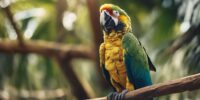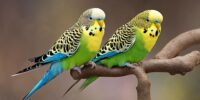Why Eclectus Parrots Have Such Distinct Sexual Dimorphism
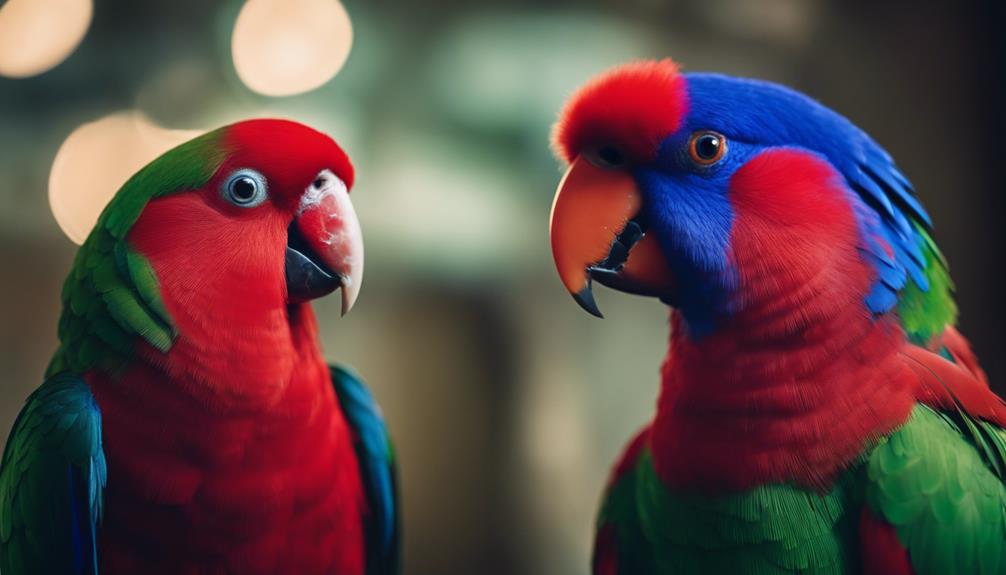
This dimorphism helps the birds identify suitable mates and reduces competition for resources within their habitats. The bright green males have blue and red accents, while the females are predominantly red with purple and blue highlights.
This unique coloration is thought to have evolved as a way to enhance reproductive success and create a clear visual distinction between the sexes.
Key Takeaways
- Extreme sexual dimorphism in Eclectus Parrots is driven by female mate choice and genetic disparities.
- Unique bill color differences and specialized diet play crucial roles in distinct plumage variations.
- Sexual selection influences vibrant male plumage, aiding in mate recognition and reproductive success.
- Understanding genetic basis and ecological influences provides insights into adaptive evolution and conservation strategies.
Evolutionary History of Eclectus Parrots
The evolutionary history of Eclectus Parrots showcases a fascinating narrative of adaptation and speciation driven by extreme sexual dimorphism. The pronounced differences in plumage between males, with their bright emerald green coloration, and females, mostly bright red with purple/blue plumage, have intrigued researchers for centuries. Early ornithologists were misled by this stark contrast, initially categorizing them as two distinct species due to their dissimilar appearances. It wasn't until the early 20th century that it was conclusively established that Eclectus Parrots were, in fact, a single species, with males and females representing extreme examples of sexual dimorphism within the avian world.
The unique evolutionary trajectory of Eclectus Parrots, shaped by their distinctive plumage and bill color differences, sets them apart from other parrot species. This remarkable adaptation for sexual selection hasn't only captured the attention of ornithologists but also underscores the intricate mechanisms at play in the evolution of this mesmerizing bird species.
Unique Feeding Habits Influence Plumage
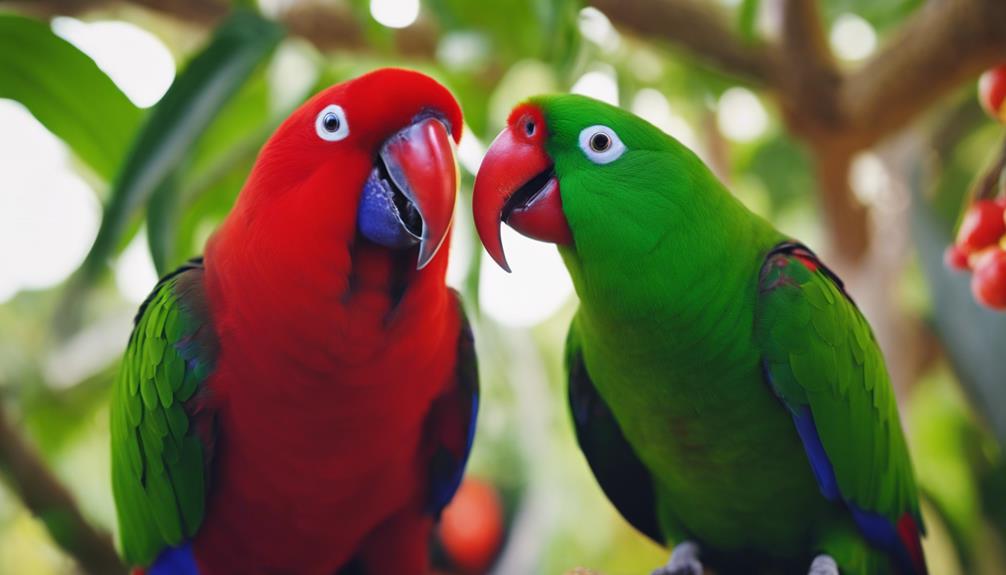
Evolutionary pressures stemming from their distinctive plumage have led Eclectus Parrots to develop unique feeding habits that significantly influence their vibrant and contrasting plumage colors. These unique feeding habits include:
- Fruit-Eating Behavior: The primary diet of Eclectus Parrots consists of fruits rich in pigments. These pigments play a crucial role in determining the vivid red and purple/blue hues seen in female Eclectus Parrots.
- Nutrient-Rich Diet: Male Eclectus Parrots, with their striking emerald green plumage, may benefit from specific nutrients in their diet that enhance their bright coloration.
- Role in Sexual Dimorphism: The specialized diet of Eclectus Parrots likely plays a pivotal role in the evolution of their extreme sexual dimorphism, where males and females exhibit such stark differences in plumage colors.
Understanding the intricate link between the feeding habits and plumage colors of Eclectus Parrots provides valuable insights into the ecological and evolutionary factors that underlie their unique sexual dimorphism.
Role of Sexual Selection in Dimorphism

Sexual selection exerts a powerful influence on the extreme sexual dimorphism observed in Eclectus Parrots. Female mate choice likely drives the evolution of the vibrant male plumage, indicating a preference for genetic fitness and health.
The distinct coloration between males and females suggests a strong role of sexual selection in shaping their appearance and enhancing reproductive success.
Evolutionary Advantage of Dimorphism
In the context of sexual dimorphism in Eclectus Parrots, the development of distinct coloration patterns serves as a critical mechanism for mate selection and reproductive success. The evolutionary advantage of dimorphism can be attributed to several factors:
- Enhanced Mate Recognition: The extreme color differences between males and females aid in easy mate recognition, reducing the chances of selecting the wrong partner.
- Genetic Signaling: Male Eclectus Parrots' bright green plumage may signal genetic quality to females, influencing their choice of mates and ultimately enhancing reproductive success.
- Species-Specific Reproduction: The stark contrast in colors between male and female Eclectus Parrots likely evolved to reduce hybridization and ensure species-specific mate selection, contributing to the preservation of the species' genetic integrity.
Mate Choice Influence
Frequently, female Eclectus Parrots exhibit a preference for brightly colored males, driving the evolution of distinct coloration patterns through generations. This mate choice influence plays a crucial role in the extreme sexual dimorphism observed in Eclectus Parrots.
The vivid plumage displayed by male Eclectus Parrots is a direct result of this selective pressure, emphasizing the significance of sexual selection in shaping their appearance. Through the mechanism of mate choice, females have propelled the evolution of striking differences in coloration between the sexes, ultimately enhancing reproductive success.
The pronounced sexual dimorphism in Eclectus Parrots underscores the powerful impact of mate choice and sexual selection on the development of distinct visual characteristics within the species.
Environmental Factors and Coloration

The environmental factors influencing the coloration of Eclectus Parrots are multifaceted, involving aspects such as diet, habitat preferences, and mating behaviors. These factors play a crucial role in shaping the distinct color patterns observed in male and female Eclectus Parrots.
Role of Diet
Eclectus Parrots exhibit distinct sexual dimorphism, with the coloration differences between males and females primarily influenced by their dietary intake rich in specific pigments and nutrients.
The vibrant green plumage of male Eclectus Parrots is a result of their diet, contributing to their emerald appearance. Conversely, female Eclectus Parrots' bright red plumage is influenced by the pigments in their diet, enhancing their striking coloration.
The dietary variations between male and female Eclectus Parrots play a vital role in shaping their unique sexual dimorphism, highlighting the importance of nutrition in their appearance. Understanding how diet affects coloration in these parrots underscores the impact of environmental factors on extreme sexual dimorphism expression in avian species.
Habitat Influences Colors
Influenced by their specific habitat characteristics, the colors of male and female Eclectus Parrots serve adaptive purposes that aid in their survival and reproductive success.
The green plumage of males allows them to blend seamlessly into the lush foliage of their rainforest and woodland habitats, providing camouflage from potential predators.
In contrast, the vibrant red feathers of females help them stand out for mate attraction and possibly seed dispersal in the dense greenery.
Evolutionary pressures have shaped these distinct colorations, enhancing the parrots' ability to thrive in their environment.
This extreme sexual dimorphism, driven by habitat influences, not only aids in their survival by avoiding detection but also plays a crucial role in ecological niche differentiation within their habitat.
Mating Behavior Effects
Shaped by their surrounding environment, the mating behavior of Eclectus Parrots reflects a complex interplay between environmental factors and the distinctive coloration of the males and females. Environmental factors like nesting habits and competition for resources influence their mating behavior significantly.
The unique coloration of male and female Eclectus Parrots also plays a crucial role in their mating behaviors and social interactions. Female Eclectus Parrots, with their vivid red plumage, exhibit distinct mating behaviors such as polyandry, influenced by their coloration and nesting habits.
The visibility of these parrots to predators and potential mates is impacted by their color differences, affecting mate selection and overall reproductive success. Understanding these mating behavior effects sheds light on the evolutionary traits and reproductive dynamics of Eclectus Parrots.
Genetic Basis for Dimorphism
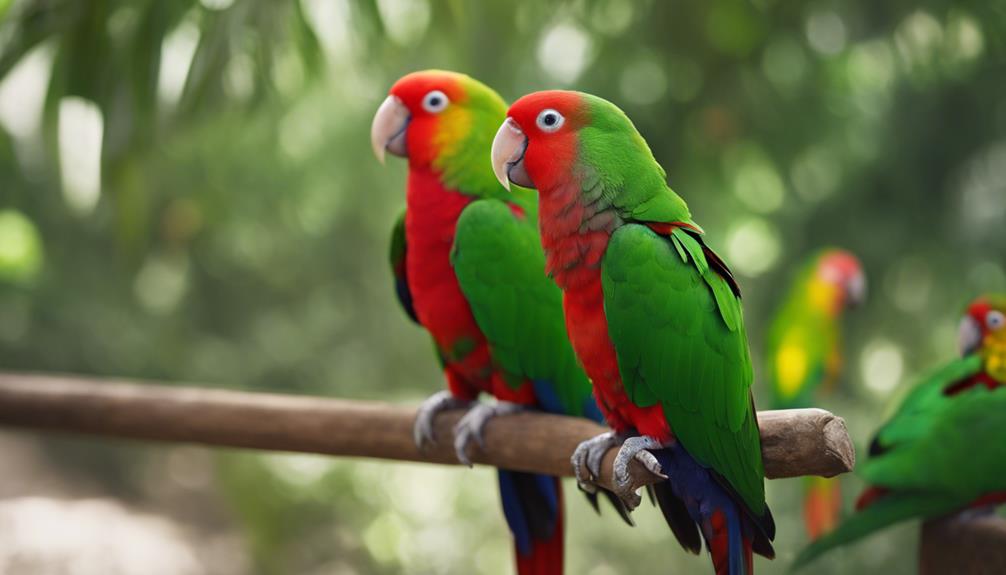
The distinct sexual dimorphism observed in Eclectus Parrots is predominantly attributed to underlying genetic mechanisms. DNA analysis has revealed specific genes responsible for the contrasting plumage in males and females. These genetic disparities lead to the production of different pigments that give rise to the vibrant green coloration seen in males and the striking red hues observed in females. The expression of sex-linked genes plays a pivotal role in determining these color differences, highlighting the intricate genetic basis for the pronounced dimorphism in Eclectus Parrots. Understanding these genetic intricacies not only sheds light on the mechanisms driving such distinct physical variations but also provides valuable insights into the evolutionary pathways that have shaped the unique appearance of these avian species.
| Genetic Basis for Dimorphism |
|---|
| DNA analysis reveals specific genes responsible for plumage differences |
| Genetic disparities result in the production of different pigments |
| Sex-linked genes determine the contrasting colors in males and females |
Behavioral Differences Between Genders
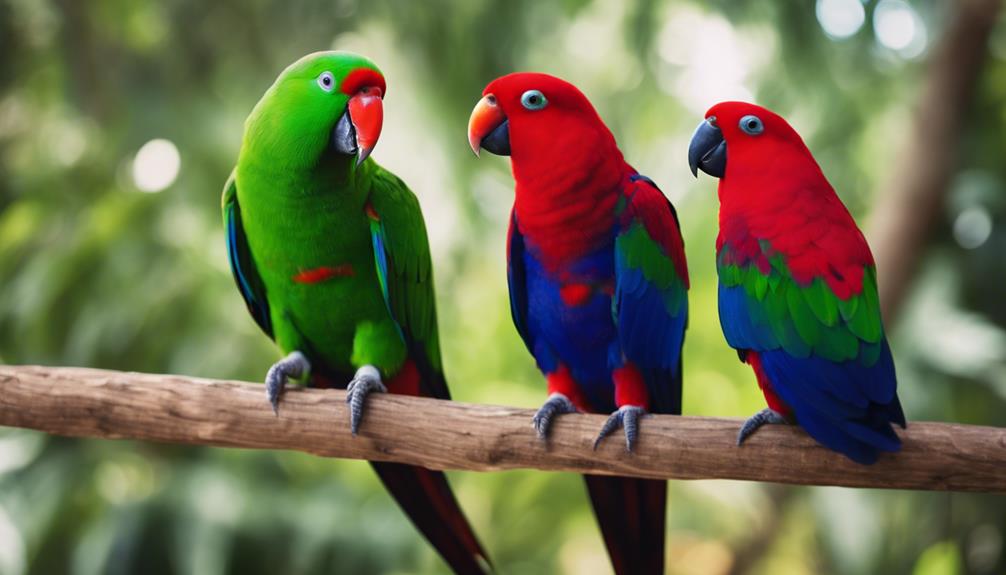
Behavioral differences between male and female Eclectus Parrots manifest in distinct patterns of activity and social interactions.
Female Eclectus Parrots focus on nesting behaviors, exhibiting unique mating behaviors such as polyandry and engaging in competition with other Eclectus and Sulphur-crested Cockatoos for nests. These behaviors are influenced by their nesting habits and the need to care for their young.
Environmental factors, such as their zygodactyl toes, play a crucial role in shaping their behavior, impacting how they interact with different surfaces and structures. In captivity, these parrots may display variations in foraging behaviors compared to their wild counterparts, adapting to the predictability of their environment.
Understanding these behavioral differences sheds light on how sexual dimorphism in Eclectus Parrots isn't only reflected in their physical appearance but also in their intricate mating rituals and nesting strategies.
Conservation Implications of Dimorphism
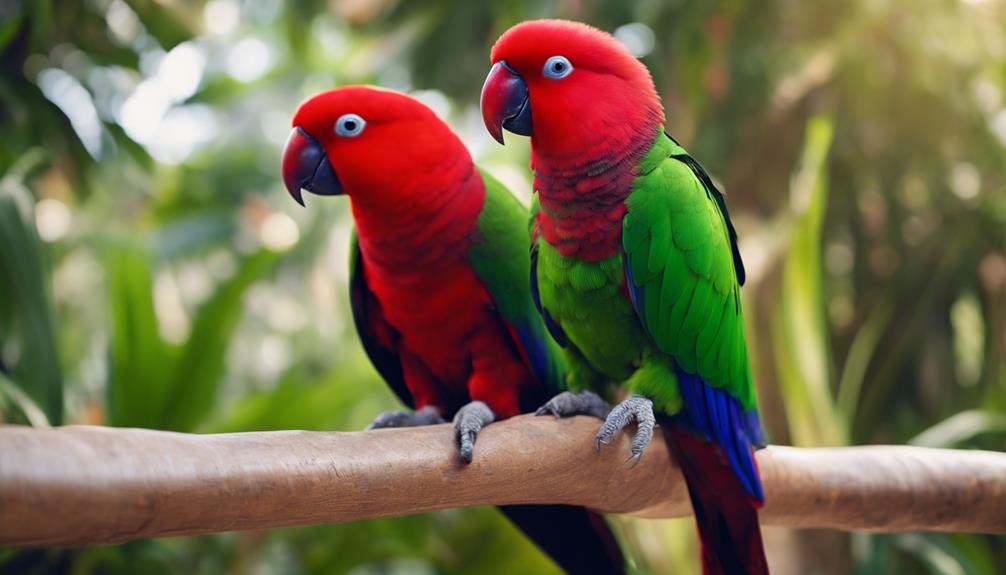
Considering the extreme sexual dimorphism of Eclectus Parrots, conservation efforts must prioritize the preservation of both male and female individuals. The striking visual disparities between sexes in Eclectus Parrots underscore the significance of safeguarding the genetic diversity present within the species. Protecting these unique traits is crucial for maintaining the overall health and resilience of the population. Understanding the conservation implications of sexual dimorphism in Eclectus Parrots can guide the development of targeted strategies aimed at ensuring their long-term survival and the conservation of their habitats.
| Category | Importance | Strategy |
|---|---|---|
| Genetic Diversity | Preserves diverse traits for species resilience | Implement breeding programs to maintain genetic variation |
| Habitat Conservation | Ensures suitable environments for both sexes | Identify and protect key habitats used by males and females |
| Ecosystem Balance | Recognizes distinct roles in the ecosystem | Promote conservation practices that benefit both genders |
| Vulnerability | Considers specific risks for each sex | Tailor conservation efforts to address male and female needs |
Frequently Asked Questions
What Is the Sexual Dimorphism of the Eclectus Parrot?
Eclectus Parrots showcase extreme sexual dimorphism. Males are vibrant green, females predominantly red. Their distinct plumage colors, size, behavior, and vocalizations set them apart. This unique feature fascinated early ornithologists, mistaking them for two distinct species.
Do Parrots Have Sexual Dimorphism?
Parrots exhibit sexual dimorphism in varying degrees, showcasing differences such as feather coloration, behavioral traits, and reproductive strategies. These variations often provide evolutionary advantages, aiding in mate attraction, resource acquisition, and overall species survival.
What Is the Difference Between Male and Female Eclectus Parrots?
The male Eclectus Parrots sport vibrant emerald green hues with blue wings and scarlet bellies, while females flaunt vivid red feathers with blue collars and belly bands. Their distinct color differences make them easily recognizable even from afar.
Why Do Some Birds Have Sexual Dimorphism?
Sexual dimorphism in birds, like Eclectus Parrots, serves evolutionary advantages in mate selection. Behavioral differences, coloration, and hormonal influences aid in reproductive success and genetic diversity. Environmental factors play a role in shaping these distinct traits.



